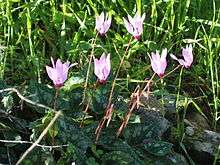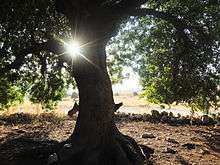Valley of Elah

The Valley of Elah, Ella Valley, "the valley of the terebinth" [1] (Hebrew: עמק האלה Emek HaElah) (Arabic وادي السنط,Wadi es-Sunt), so called after the large and shady terebinth trees (Pistacia atlantica) which are indigenous to its parts, and best known as the place described in the Bible where the Israelites were encamped when David fought Goliath (1 Sam. 17:2, 19). It was near Azekah and Socho (17:1). On the west side of the valley, near Socho, there is a very large and ancient tree of this kind, 55 feet in height, its trunk 17 feet in circumference, and the breadth of its shade no less than 75 feet. It marks the upper end of the valley, and forms a noted object, being one of the largest terebinths in the area. Rising up from the valley on its extreme south-east end lies the hilltop ruin, Adullam.

The Valley of Elah has gained new importance as a possible point of support for the argument that Israel was more than a tribal chiefdom in the time of King David. At Khirbet Qeiyafa, southwest of Jerusalem in the Elah Valley, Prof. Yosef Garfinkel has discovered a fortified city from the Iron Age IIa dated sometime between 1050 and 915 BC. The fortifications have been said to support the biblical account of the United Monarchy at the beginning of Iron Age II.[2] Others are sceptical, and suggest it might represent either a Judahite or Canaanite fortress.[3]


In the late 19th century, Conder and Kitchener described the Elah valley as being "one of the most fertile districts in Palestine. It is an open flat vale about half a mile across, and covered with corn; a narrow trench runs down the centre full of white pebbles worn by the water in winter. Here and there large terebinths grow along its course (Butmet Wâdy es Sûr), and solitary oak trees (Ballûtet Kŭssis). On either side rise the stony hills covered with brushwood and wild growth."[4]
Since the early 1970s, the valley has also contained a large satellite relay station, with an antenna farm containing some 120 satellite dishes of various sizes.
Today the valley is threatened by shale oil extraction through the CCR ground-heating process, with the Green Zionist Alliance and the grassroots group Save Adullam, among others, working to stop shale oil extraction in the region.[5][6][7]
Flora
Although many are plant species native to the Elah Valley, here are a few of the more popular plants (trees, flowers and herbs) that can be seen in the valley:
- Terebinth (Pistacia atlantica, var. Pistacia palaestina)
- Kermes oak (Quercus calliprinos)
- Buckthorn (Rhamnus lycioides)
- Carob (Ceratonia siliqua)
- Sweet Marjoram (Majorana syriaca; syn. Origanum syriacum)
- Sage (Salvia fruticosa)
- Toothpick (Ammi visnaga)
- Florence fennel (Foeniculum vulgare)
- Anemone (Anemone coronaria)
- Cyclamen (Cyclamen persicum)
- Lupine (Lupinus pilosus)
- Daisy (Glebionis coronaria)
- Syrian Cornflower-thistle (Centaurea cyanoides) - rare
- Mallow (Malva nicaeensis)
- Asparagus (Asparagus palaestinus)
- Chicory (Cichorium pumilum; syn. Cichorium endivia)
- Broom Lettuce (Lactuca serriola)
- Stinging Nettle (Urtica urens)
- Asphodel (Asphodelus aestivus)
- Wild Oat (Avena sterilis)
- Wild Barley (Hordeum spontaneum; syn. H. ithaburense)
- Wild Mustard (Sinapsis alba)
- Arum; Cuckoo-Pint (Arum palaestinum)
- Caper (Capparis spinosa)
- Wild carrot (Daucus carota)
- Globe-thistle (Echinops adenocaulos)


Fauna
Here are a few of the animal species native to the Elah Valley:
- Mountain Gazelle (Gazella gazella)
- Golden jackal (Canis aureus syriacus)
- Syrian fox (Vulpes thaleb)
- Crested Porcupine (Hystrix cristata)
- Egyptian Mongoose (Herpestes ichneumon)
- Hedgehog (Erinaceus concolor)
- Middle East blind mole-rat (Spalax ehrenbergi; syn. Nannospalax ehrenbergi)
- Spur-thighed tortoise (Testudo graeca)
- Günther's vole (Microtus guentheri)
- Legless lizard (Pseudopus apodus)
See also
References
- ↑ Elah, Langenscheidt's Hebrew Dictionary, Dr Karl Feyerabend
- ↑ Govier, Gordon "Archaeology: What an Ancient Hebrew Note Might Mean" Christianity Today 1/18/2010
- ↑ Julia Fridman, 'Crying King David: Are the ruins found in Israel really his palace? ,' at Haaretz, 26 August, 2013.
- ↑ C.R. Conder & H.H. Kitchener, The Survey of Western Palestine, vol. III, London 1883, p. 298
- ↑ Krantz, David (1 May 2011). "Israel: The New Saudi Arabia?". Jewcology.
- ↑ Cheslow, Daniella (18 Dec 2011). "Shale oil project raises hackles in Israel". AFP.
- ↑ Laylin, Tafline (5 March 2013). "Saudi Turns to Solar, Israel Stuck on Shale". Green Prophet.
External links
| Wikimedia Commons has media related to Valley of Elah. |
Gallery
 Panoramic view of Elah Valley and Neve Michael as seen from atop Moshav Aderet
Panoramic view of Elah Valley and Neve Michael as seen from atop Moshav Aderet The Valley of Elah, near Adullam
The Valley of Elah, near Adullam Elah Valley as seen from atop of Tel Socho
Elah Valley as seen from atop of Tel Socho View of Elah Valley, looking east from atop of Tel Socho
View of Elah Valley, looking east from atop of Tel Socho Elah Valley, en route to Tel Socho
Elah Valley, en route to Tel Socho%2C_March_2015.jpg) Crown daisy (Glebionis coronaria)
Crown daisy (Glebionis coronaria) Pistacia atlantica, from which the valley takes its name
Pistacia atlantica, from which the valley takes its name Beneath the shady boughs of a Persian turpentine tree (Pistacia atlantica) in the Elah valley
Beneath the shady boughs of a Persian turpentine tree (Pistacia atlantica) in the Elah valley
Coordinates: 31°41′25.10″N 34°57′07.70″E / 31.6903056°N 34.9521389°E